|
|
|
Sort Order |
|
|
|
Items / Page
|
|
|
|
|
|
|
| Srl | Item |
| 1 |
ID:
096559
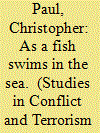

|
|
|
|
|
| Publication |
2010.
|
| Summary/Abstract |
This article reviews and synthesizes social science knowledge on the connections between popular support and terrorist/insurgent sustainment. After distinguishing between "sympathetic of" and "supporting," the author identifies support requirements of terrorists and insurgents, the range of sources of support, and motives for support. A scheme of relationships between factors contributing to strength of support is essayed. As a caveat to population-centered approaches to counterterrorism and counterinsurgency, the article concludes that support is not "one size fits all," and that certain factors, when present, are more amenable to policy influence than others. These conclusions suggest that it is imperative that practitioners of counterterrorism and counterinsurgency be mindful of the specifics of their case when seeking to undermine support.
|
|
|
|
|
|
|
|
|
|
|
|
|
|
|
|
| 2 |
ID:
084088
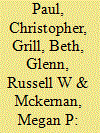

|
|
|
|
|
| Publication |
2008.
|
| Summary/Abstract |
Although great strides have been made toward forecasting state-level instability, little progress has been made toward the prediction of outbreaks of urban unrest. This article presents a method for the assessment of cities' vulnerability to large-scale urban unrest. Forty-five factors correlated with urban unrest are identified and weighted by an expert panel. Based on expert elicitation through an iterative Delphi exercise, the explicitly methodological discussion describes both the process and the resulting assessment framework. Results include a tool that will allow users to rank cities on their vulnerability to large-scale urban unrest
|
|
|
|
|
|
|
|
|
|
|
|
|
|
|
|
| 3 |
ID:
069771


|
|
|
|
|
| Publication |
Santa Monica, Rand Corporation, 2001.
|
| Description |
xx, 45p.
|
| Standard Number |
0833029681
|
|
|
|
|
|
|
|
|
|
|
|
Copies: C:1/I:0,R:0,Q:0
Circulation
| Accession# | Call# | Current Location | Status | Policy | Location |
| 044059 | 355.6223/KEA 044059 | Main | On Shelf | General | |
|
|
|
|
| 4 |
ID:
054347
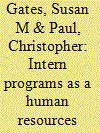

|
|
|
|
|
| Publication |
Santa Monica, Rand Corporation, 2004.
|
| Description |
xxviii, 101p.
|
| Standard Number |
083303569X
|
|
|
|
|
|
|
|
|
|
|
|
Copies: C:1/I:0,R:0,Q:0
Circulation
| Accession# | Call# | Current Location | Status | Policy | Location |
| 048783 | 355.61969/GAT 048783 | Main | On Shelf | General | |
|
|
|
|
| 5 |
ID:
148047
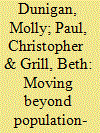

|
|
|
|
|
| Summary/Abstract |
Historically, insurgency is one of the most prevalent forms of armed conflict and it is likely to remain common in the foreseeable future. Recent experiences with counterinsurgency in Iraq and Afghanistan offer many lessons for future counterinsurgents, but the discourse on the subject continues to be mired in a traditional dichotomy pitting population-centric approaches to counterinsurgency against enemy-centric approaches. Historical analysis suggests that this traditional dichotomy is not a sufficiently nuanced way to understand or plan for such operations. Instead, discussions of counterinsurgency should focus on two dimensions: actions (use of physical force vs. political or moral actions) and targets (active insurgents vs. insurgent support). This perspective divides the space of possible counterinsurgency efforts into four quadrants, suggesting that effective counterinsurgency campaigns find a balance of effort across the four quadrants that is well matched to the specific context.
|
|
|
|
|
|
|
|
|
|
|
|
|
|
|
|
| 6 |
ID:
131323


|
|
|
|
|
| Publication |
2014.
|
| Summary/Abstract |
An age-old form of warfare, insurgency is still a problem for many governments today and merits careful study. Regional governments, global coalitions and international security policy-makers--all have an interest in finding the ways and means of countering such challenges. Historical analysis provides a good foundation for understanding the problem and seeking solutions to it. The Rand Corporation has undertaken an extensive and detailed comparative examination of insurgencies begun and completed worldwide since the Second World War, focusing on the 71 most recently resolved conflicts in particular. The findings of this important study provide useful guidelines for implementing an effective counter-insurgency strategy.
|
|
|
|
|
|
|
|
|
|
|
|
|
|
|
|
| 7 |
ID:
060033
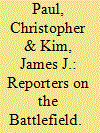

|
|
|
|
|
| Publication |
Santa Monica, Rand Corporation, 2004.
|
| Description |
xxiii, 150p.
|
| Standard Number |
0833036548
|
|
|
|
|
|
|
|
|
|
|
|
Copies: C:1/I:0,R:0,Q:0
Circulation
| Accession# | Call# | Current Location | Status | Policy | Location |
| 049312 | 070.4333/PAU 049312 | Main | On Shelf | General | |
|
|
|
|
| 8 |
ID:
095954
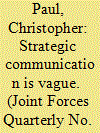

|
|
|
| 9 |
ID:
083476
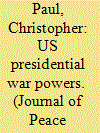

|
|
|
|
|
| Publication |
2008.
|
| Summary/Abstract |
Using the events leading to the War Powers Resolution of 1973 and its subsequent impact on US military interventions as an empirical example, this article elaborates the notion of `legacy chains'. Expanding on the general notion of policy legacies, the discussion describes the effects that post-World War II US military interventions have had on each other through the policy legacies left by each in turn. The argument allows that military intervention legacies have their strongest impact on decisionmaking for an immediately subsequent intervention but can also leave durable impressions on the institutional context, which, after being modified by subsequent military interventions, constitute `legacy chains'. These legacy chains are path-dependent processes, in that their institutional embodiments follow `increasing returns' logics and will remain in place until the structure of returns changes, usually due to a `critical shift'. In response to a series of perceived abuses of presidential war powers following World War II, the War Powers Resolution sought to ensure congressional participation in future commitments of US forces to hostilities. It has not done so. The lasting legacy of the War Powers Resolution is an unintended consequence of the way it was formally institutionalized. Presidents, following the letter of the resolution, have designed post-War Powers Resolution military interventions to either be short (so the 60-day mandatory reporting period specified in the resolution ends with a fait accompli) or popular, so that public and congressional opinion are sufficient to ensure approval of the operation, either before it starts or once underway. While the actual legacy of the War Powers Resolution is not what was intended at its inception, it is unlikely to be formally changed until a future (hypothetical) abuse of war powers sufficiently egregious to break through its institutional inertia.
|
|
|
|
|
|
|
|
|
|
|
|
|
|
|
|
|
|
|
|
|